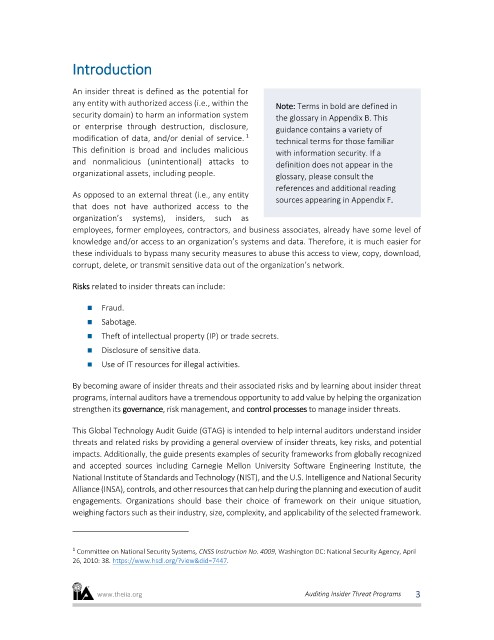Page 370 - ITGC_Audit Guides
P. 370
Introduction
An insider threat is defined as the potential for
any entity with authorized access (i.e., within the Note: Terms in bold are defined in
security domain) to harm an information system the glossary in Appendix B. This
or enterprise through destruction, disclosure, guidance contains a variety of
1
modification of data, and/or denial of service. technical terms for those familiar
This definition is broad and includes malicious with information security. If a
and nonmalicious (unintentional) attacks to definition does not appear in the
organizational assets, including people. glossary, please consult the
references and additional reading
As opposed to an external threat (i.e., any entity
sources appearing in Appendix F.
that does not have authorized access to the
organization’s systems), insiders, such as
employees, former employees, contractors, and business associates, already have some level of
knowledge and/or access to an organization’s systems and data. Therefore, it is much easier for
these individuals to bypass many security measures to abuse this access to view, copy, download,
corrupt, delete, or transmit sensitive data out of the organization’s network.
Risks related to insider threats can include:
Fraud.
Sabotage.
Theft of intellectual property (IP) or trade secrets.
Disclosure of sensitive data.
Use of IT resources for illegal activities.
By becoming aware of insider threats and their associated risks and by learning about insider threat
programs, internal auditors have a tremendous opportunity to add value by helping the organization
strengthen its governance, risk management, and control processes to manage insider threats.
This Global Technology Audit Guide (GTAG) is intended to help internal auditors understand insider
threats and related risks by providing a general overview of insider threats, key risks, and potential
impacts. Additionally, the guide presents examples of security frameworks from globally recognized
and accepted sources including Carnegie Mellon University Software Engineering Institute, the
National Institute of Standards and Technology (NIST), and the U.S. Intelligence and National Security
Alliance (INSA), controls, and other resources that can help during the planning and execution of audit
engagements. Organizations should base their choice of framework on their unique situation,
weighing factors such as their industry, size, complexity, and applicability of the selected framework.
1 Committee on National Security Systems, CNSS Instruction No. 4009, Washington DC: National Security Agency, April
26, 2010: 38. https://www.hsdl.org/?view&did=7447.
www.theiia.org Auditing Insider Threat Programs 3

